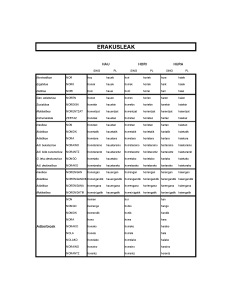When I was trying to learn Basque, one shortcoming I had as an English speaker is that I simply didn’t know the grammatical lingo. There are a lot of terms thrown about – declenation, ergative, auxiliary verb – that are used to describe the grammar that we simply don’t learn in English class. At least, I didn’t. Even when English has the same concepts. Maybe it’s just that we don’t learn it so “academically” when it is our native language. In any case, whenever you look at a Basque grammar book in English, they always refer to these mysterious-sounding concepts that were quite foreign to me.

- Basque is an agglutinative language. What this means is that elements can be joined together to form longer words and, importantly, those elements can be isolated and their meaning identified. This is in contrast to fusional languages, in which elements contain multiple meanings at once.
- Basque is an ergative-absolutive language. This is a bit tricky for me to understand (this Quora thread helped), but essentially it means that if you go from an intransitive verb to a transitive verb (for example, “He eats” vs “He eats pie” in English), while in English “He” remains the same as it is the subject in both, in Basque, because in one there is no object in the other there is, “He” changes to make this. The absolutive label means that, in Basque, the subject of an intransitive verb and the object of a transitive verb have the same case, while the ergative label means that the subject of a transitive verb has a different case.
- Blas lo dago. Blas is sleeping. Blas is the subject.
- Lisa lo dago. Lisa is sleeping. Lisa is the subject.
- Blasek Lisa ikusi du. Blas sees Lisa. Blas is the subject and Lisa is the object. Blas changes but Lisa does not.
- Basque is a subject-object-verb (SOV) language. In contrast, English, Spanish, and French are SVO languages. SOV means that the verb comes at the end of the sentence. While this may seem strange, more of the world’s languages are SOV like Basque than SVO like English. No language is 100% any specific order – in English, we do construct SOV phrases such as “I thee wed.” Further, in Basque, the order of the various elements can change to emphasize or focus on different components, so it is even less rigid than English in this regard.
- Basque has an auxiliary verb that exhibits polypersonal agreement. That Basque has an auxiliary verb means that there is an extra word added to verbs to indicate things like tense or person. That this verb indicates polypersonal agreement means that it changes in response to more than one of its arguments. That is, the verb is different if you have a subject, a subject plus an object (and it changes if it is direct or indirect), or if you have both. It also changes if you have one or more than one object…
- Basque is a highly inflected language. Inflection means that words are modified or changed to indicate various things such as tense or number. In English, “-s” to indicate plural is an example of inflection. In Basque, there are seventeen cases for noun phrases, meaning seventeen different modifiers to indicate things like who did what, to whom, for whom, when, whose, and to where, for example. Further, these can be further inflected in many cases. It has been estimated that a noun can therefore take in excess of 450,000 inflected forms. As one example, etxearena (that which is of the house) can be declined to yield etxearenarekin (with the one which pertains to the house).
A full list of all of Buber’s Basque Facts of the Week can be found in the Archive.
Primary sources: The Nature of the Basque Language, Thayer Watkins; Basque Language-Grammar, Wikipedia
Discover more from Buber's Basque Page
Subscribe to get the latest posts sent to your email.



How many drafts did it take to write this one up?!
Dutch
Only one draft but I had to do a lot of looking up of terms!